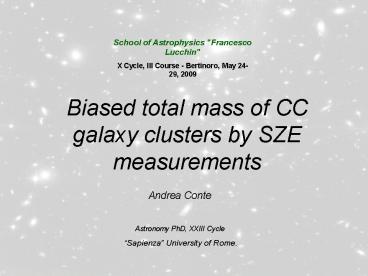Diapositiva 1 - PowerPoint PPT Presentation
Title: Diapositiva 1
1
School of Astrophysics "Francesco Lucchin" X
Cycle, III Course - Bertinoro, May 24-29, 2009
Biased total mass of CC galaxy clusters by SZE
measurements
Andrea Conte Astronomy PhD, XXIII Cycle
Sapienza University of Rome.
2
Outline
- Brief introduction to the Sunyaev Zeldovich
Effect, - SZE as mass finder and its assumptions,
- Discussion on the ICg properties
- electron number density
- electron temperature
- SZ flux simulations for two ICg templates cool
core and isothermal b model, - Bias on the cluster total mass.
Andrea Conte - Biased total mass of CC
galaxy clusters by SZE measurements
3
Sunyaev-Zeldovich Effect
SZE is the comptonization of the CMB photons by
high energy electrons of the ICg.
The scattering processes produce photons energy
change.
Andrea Conte - Biased total mass of CC
galaxy clusters by SZE measurements
4
SZ as mass finder
- SZE Properties
- unique spectral shape
- redshift independent
- ? electron pressure in cluster atmospheres
(Mohr and Carlstrom)
- Cosmology
- H0
- ?B
- evolution of abundance of clusters
- TCMB(z)
(Luzzi, , Conte et al., in preparation)
- Galaxy clusters Physics
- ? optical depth
- Te electron temperature
- vpec peculiar velocity
- M cluster total mass
(Carlstrom et al., 2002)
- SZ as mass finder
- large galaxy clusters surveys
- self-similarity scaling laws
Andrea Conte - Biased total mass of CC
galaxy clusters by SZE measurements
5
Electron Number Density
The parameterized model usually employed to study
cluster physics is the isothermal b model
(Cavaliere et al., 1976)
The b model density distribution is integrated to
get the projected X-ray surface brightness
profile.
(LaRoque et al., 2006)
Central excess emission not correctly described
(Mohr et al., 1999)
If tcool lt tH the ICg can cool e flow towards
the cluster center. The density increases in the
cluster core (in contrast with the hydrostatic
model) and the gas temperature exhibits a maximum
at 2rc and then it drops down to the center.
(LaRoque et al., 2006)
Andrea Conte - Biased total mass of CC
galaxy clusters by SZE measurements
6
Electron Temperature
Following self-similarity studies, ten CC
clusters from a Chandra sample have been
selected. The composite radial temperature
profiles is shown, after scaling the temperature
and the radii, opportunely.
(Conte et al. in preparation)
(Bonamente et al., 2006, Morandi et al., 2007)
There is not a uniquely defined average cluster
temperature, it depends on the method used to
extract this quantity (e.g. spectroscopic,
emission weighted, gas-mass weighted).
Andrea Conte - Biased total mass of CC
galaxy clusters by SZE measurements
7
Analysis MCMC
SZE measurements can enhance or hide the presence
of a cluster cool region.
CC model
Hydrostatic equilibrium within the chosen
overdensity
isothermal b model
(Conte et al. in preparation)
Andrea Conte - Biased total mass of CC
galaxy clusters by SZE measurements
8
Analysis SZ signal
Estimation of the CMB temperature distortion due
to the SZE, for the two cluster models
- several fovs used to convolve the map (_at_142 GHz)
Andrea Conte - Biased total mass of CC
galaxy clusters by SZE measurements
9
Analysis SZ signal
Estimation of the CMB temperature distortion due
to the SZE, for the two cluster models
- MAD (Multi Array of Detectors) experiment
spectral frequencies (142, 217, 269, 353 GHz) 3x3
array of bolometers.
(Conte et al. in preparation)
Andrea Conte - Biased total mass of CC
galaxy clusters by SZE measurements
10
Conclusions
- Different results for different instruments
- small fov allows a better description of the
cluster physics (ACT, SPT, APEX-SZ), - large fov hides the presence of the cooling flow
and yields an incorrect interpretation of the
detected signal or wrong assumptions on the
cluster physics (Planck), - small fov and large surveys (SAGACE)
- cluster total mass is biased by the different
assumption on the physics of the ICg, - accurate cluster temperature profiles are needed
to correctly estimate the total mass bias, - the final goal is to carefully apply scaling
laws in presence of CC clusters.
Andrea Conte - Biased total mass of CC
galaxy clusters by SZE measurements































